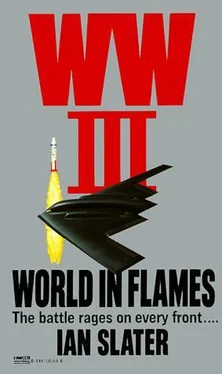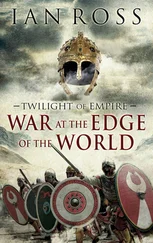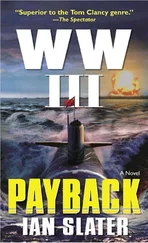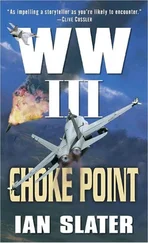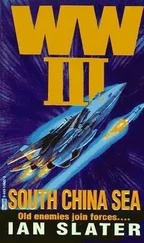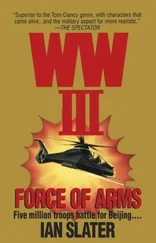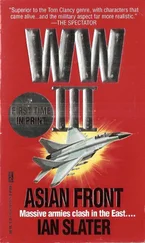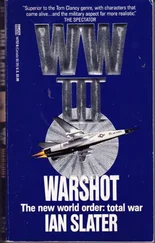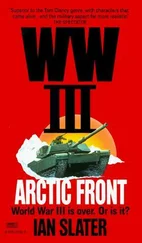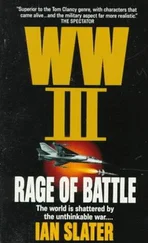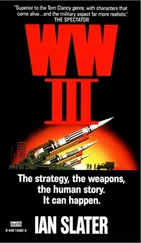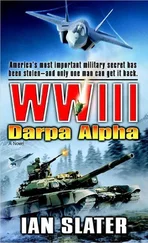Ian Slater - World in Flames
Здесь есть возможность читать онлайн «Ian Slater - World in Flames» весь текст электронной книги совершенно бесплатно (целиком полную версию без сокращений). В некоторых случаях можно слушать аудио, скачать через торрент в формате fb2 и присутствует краткое содержание. Год выпуска: 1991, ISBN: 1991, Издательство: Ballantine Books, Жанр: Триллер, на английском языке. Описание произведения, (предисловие) а так же отзывы посетителей доступны на портале библиотеки ЛибКат.
- Название:World in Flames
- Автор:
- Издательство:Ballantine Books
- Жанр:
- Год:1991
- ISBN:0-449-14564-6
- Рейтинг книги:5 / 5. Голосов: 1
-
Избранное:Добавить в избранное
- Отзывы:
-
Ваша оценка:
- 100
- 1
- 2
- 3
- 4
- 5
World in Flames: краткое содержание, описание и аннотация
Предлагаем к чтению аннотацию, описание, краткое содержание или предисловие (зависит от того, что написал сам автор книги «World in Flames»). Если вы не нашли необходимую информацию о книге — напишите в комментариях, мы постараемся отыскать её.
World in Flames — читать онлайн бесплатно полную книгу (весь текст) целиком
Ниже представлен текст книги, разбитый по страницам. Система сохранения места последней прочитанной страницы, позволяет с удобством читать онлайн бесплатно книгу «World in Flames», без необходимости каждый раз заново искать на чём Вы остановились. Поставьте закладку, и сможете в любой момент перейти на страницу, на которой закончили чтение.
Интервал:
Закладка:
CHAPTER THREE
From the high-resolution satellite pictures, the Politburo had clearly seen the vast North German Plain streaked with a white mange of snow, crisscrossed with Allied pontoon bridges over the tributaries to the Elbe and strewn with all the detritus of war: eviscerated, still-smoking armored columns, gutted empty gasoline dumps, and bloated bodies, all indicating how rapidly the Americans were advancing and the Russians retreating. The American general, Freeman, was obviously moving so fast that Soviet divisions hadn’t time to bury their dead.
Sergei Marchenko, one of the Soviet fighter pilots temporarily seconded from the Far Eastern TVD Aleutian section to plug the gaps opened up by the American breakout from the Dortmund-Bielefeld pocket to the North German Plain, was coming in low over the white ribbon of the E-8, the 120-mile autobahn between Berlin and what, before Gorbachev, used to be the frontier of Western Germany. His Foxbat-A MiG-25, one of a combat pair, crossed the Elbe seven miles northeast of Magdeburg. He pressed the “ARM” switch for four Acrid 6 air-to-air missiles, two of them infrared-homing, the other two radar-homing. The two fighter interceptors, with no internal armament, were equipped with external pod-mounted twenty-three-millimeter cannons to be used strafing either NATO supply lines or NATO fighters covering the American advance.
Sergei Marchenko was no coward, but he, like the other pilots rushed to the western front, hoped that the SPETS units, long in place in Western Europe, would help slow the American advance by sabotaging their forward airfields, which the Americans were so good at laying down despite the slushy conditions of a temporary thaw in the freezing weather.
Besides, as much as Sergei Marchenko enjoyed being a fighter pilot after his military slog through the armored corps, to which he had originally been assigned because of his height, he would have preferred to be flying the somewhat slower but more maneuverable Sukhoi-15 Flagon. It had served him so well at his home base in the Aleutians during the attacks on the American outposts of Adak submarine base and Shemya Island. In supporting the SPETS operation against Shemya, the United States’ largest western radar warning post, the Sukhois, flying out of the Komandorskiye Islands less than two hundred miles from the Americans’ westernmost island, had performed exceptionally well. It was true that Marchenko, despite his impressive record of five unichtozhennykh —”kills”—had been shot down by an American F-14 Tomcat from the U.S. carrier Salt Lake City, reputedly flown by the American ace Shirer. Marchenko had ejected, been picked up within ten minutes, and was back at Komandorskiye base within three hours. But pilots who survived a plane shot up in a dogfight tended to grow more, not less, attached to the make, and so it was with Marchenko.
Still, he knew it was silly to become sentimental about such things, and one had to learn to adapt quickly amid the vicissitudes of a rapidly changing war. In any event, Marchenko and his wingman had been buoyed by the information given them during engine-start that intelligence reports showed Allied pilots in Europe were being forced to fly in excess of six sorties a day in order to try to deal with the swarms of Russian fighters now being funneled in from the eastern sectors of the USSR.
It was predicted that at this unheard-of — except for the Battle of Britain — sortie rate, sooner or later the unrelenting fatigue would take its toll, not only on pilots and the radar-intercept officers who flew with them, but also on the ground crews. But the Russian estimates were wide of the mark, for while there had been even more casualties than they thought, British and American pilots were not about to ease off or pause to catch their breath — not after the American army, spearheaded by Freeman’s corps, had finally breached the Soviet ring of steel. The Allied pilots were like marathon runners, worn down but suddenly invigorated by a second wind — in this case provided by Freeman’s breakout from the DB pocket and by the possibility of quickly gaining ground. To make up for air crew losses, many of the British and American aircraft normally crewed by pilot and RIOs were being flown with pilot only — doing what he could with the electronic countermeasures but going up anyway, disdaining second-by-second control over all the avionics in favor of pressing home the attack, going air-to-air, giving maximum attention to dogfight maneuvers.
Coming in from the southwest over Gottingen and the recaptured airfields of lower Saxony, a flight of two F-16A Fighting Falcons, though not yet visible against the bright whiteness of blue-patched nimbostratus, could be seen quite clearly on Marchenko’s fifty-two-mile look-down Fox Fire radar.
Unaware he was already on the Soviets’ radar, Kurt Schulz, an American from Los Angeles, now picked up one of the Russians on his Dalmo Victor AN/ALR radar-warning receiver, the computer telling him the Russian fighters were now in excess of Mach 2.3—his Falcon’s top speed, Mach 2. Lying back in full recline, sidestick mode of the F-16 to reduce the G force, Schulz pressed the zoom toggle, bringing up the DA A— designated area of attack — the blipping rectangle showing cattle grazing against sodden, snow-slushed fields either side of the highway where once the tall barbed wire had stood. The black streaks Schulz could see in the zoom shot were slicks of oil visible against the unthawed shoulder of the road where snow had remained. Then there were other streaks against the snow — these rising from the ground toward him, as SAM sites opened up from the Harz foothills to the south. Schulz immediately noted on his kneepad that the SAM sites had shifted from the day before and so were presumed to be mobile launchers. In the distance he could now see the two Russians, specks of silver, closing fast, and he was alert for an ELOK — enemy lock-on tone. Radio silence was pointless now that visual ID had been made, and he asked his wingman, “That barn down there — eleven o’clock — was it there yesterday?”
There was such a deafening noise, it made Shulz grimace. He lost the video image momentarily as the plane shifted violently left. He went to “jammer” to play havoc with the SAM radars. Coming up at him at over five hundred miles an hour from less than three hundred feet, the terrain below him now a racing white-green blur, Schulz dropped two iron bombs and let the afterburner have its head. The barn was gone; so was his wingman, a young pilot he’d met only that morning as they’d raced from the ready room in response to the scramble horn. At five thousand, Schulz banked hard, the sun glinting behind him as he turned to take another run at the broken span across the Elbe, where he’d spotted the black marks against the snow. Possibly they were tire ruts, leading down from the highway to the water’s edge, more tracks coming up from the other side of the river through snow. “A “sunken” pontoon bridge?
The flak was thick, and he saw a burst of red tracer catching the sun, fading, climbing leisurely up toward him through the smoke of the barn, more tracer now coming from the direction of Magdeburg. He was into the smoke, turning tightly, coming in low again, the HUD lines flicking rapidly, the four green diamonds closing spastically. The smoke was gone. He saw the wreckage of the SAM site in the barn he’d destroyed littering the icy green fields, some of its debris caught in a high mesh fence either side of the autobahn. Schulz knew it was only a matter of minutes before the MiGs, rising like silver gnats in his rear vision from Stendal, would be on him. He set the “clicker”—automatic release — when the river section he’d chosen on his TV zoom was mirrored in the radar image. The Falcon rose as the bombs released. The plane yawed slightly and he headed south, climbing to clear the Harz, hoping to lose himself in cloud, black puffs of flak from the AA batteries around Stassfurt and Aschersleben smudging the air about him.
Читать дальшеИнтервал:
Закладка:
Похожие книги на «World in Flames»
Представляем Вашему вниманию похожие книги на «World in Flames» списком для выбора. Мы отобрали схожую по названию и смыслу литературу в надежде предоставить читателям больше вариантов отыскать новые, интересные, ещё непрочитанные произведения.
Обсуждение, отзывы о книге «World in Flames» и просто собственные мнения читателей. Оставьте ваши комментарии, напишите, что Вы думаете о произведении, его смысле или главных героях. Укажите что конкретно понравилось, а что нет, и почему Вы так считаете.
